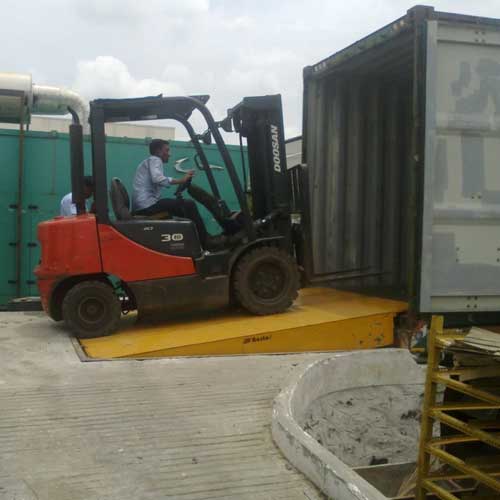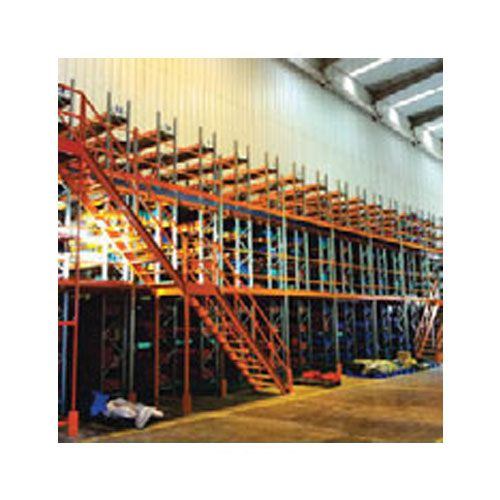Schedule a Call Back
Why efficient material handling is essential for the success on Make in India
 Articles
Articles- May 30,25

Table 1: Indian material handling equipment market size and forecast (in $ million)
Year | Market (in $ Mn) |
2022 | 2,668.74 |
2023 | 2,882.24 |
2024 | 3,132.63 |
2025 | 3,426.42 |
2026 | 3,771.54 |
2027 | 4,177.71 |
Courtesy: iNDEXTb (A Govt of Gujarat organisation)
Industry experts believe the ability to manufacture at scale is only meaningful if it is matched by the ability to move, store, and deliver at speed. "Autonomous, intelligent material handling is the only way India can compress its logistics cost—which remains at 13–14 per cent of GDP—closer to global benchmarks. Without this transformation, Make in India risks remaining a slogan rather than a supply chain reality,” explains Robinson Philipose, Co-Founder and CEO, ARAPL RaaS Pvt Ltd.
Need for efficient logistics
The country's economic objectives, which include reaching a GDP of $ 5.5 trillion by 2027, depend on the transformation of India's logistics industry. Kaushik says, "The sector supports businesses such as manufacturing, agriculture, and e-commerce, accounting for 13-14 per cent of GDP and employing over 22 million people. The logistics industry can lower costs, increase competitiveness, and boost economic growth by improving supply chain efficiency.”
High logistics costs and underdeveloped infrastructure are among the major challenges India faces compared to other leading economies. Rao observes, "Currently, logistics expenses account for approximately 16 per cent of India’s GDP, whereas in many advanced nations, these costs are in single digits. The situation is further exacerbated by inadequate road infrastructure—even though nearly 60 per cent of the freight is transported by road. Additional factors such as high land acquisition costs, complex legal frameworks, and volatile diesel prices further drive up logistics costs, hindering overall efficiency and competitiveness."
According to Madisetty, the Indian logistics sector is like a 1990s computer trying to run a 2025 software—there’s immense potential, but the system needs a serious upgrade. “The biggest roadblock is fragmentation. We still rely on hundreds of small, uncoordinated players, operating in silos with little digital traceability. Many warehouses still function like godowns—manual registers, no racking, and zero tech,” he adds.
India’s warehousing sector has historically been fragmented, labour-intensive, and undercapitalised. "On the one hand, fragmented supply chains, inadequate multimodal integration, and legacy warehousing formats act as bottlenecks. On the other hand, the absence of unified digital platforms and varied compliance requirements across states delay efficiencies. However, these challenges open the door to massive transformation. The introduction of the PM Gati Shakti National Master Plan, coupled with dedicated freight corridors, integrated logistics parks, and policy impetus from the National Logistics Policy (NLP), are strong directional shifts. There’s a significant opportunity to digitise, consolidate, and formalise the sector—especially with the rise of e-commerce and export-oriented manufacturing,” says Barboza.
Need for modernisation
As India focuses on boosting manufacturing, warehousing ensures safe, timely, and efficient storage of raw materials and finished goods. Ajay Gupta, Managing Director, Indian Extraction Ltd, says, "With global disruptions like tariff wars and geopolitical tensions, Indian manufacturers need well-placed, well-managed warehouses to reduce costs and avoid delays. Efficient warehousing helps maintain product quality, improves inventory management, and supports faster market access.”
In 2025, India’s warehousing industry is growing rapidly due to increasing domestic and export demand. “Modern, large-scale warehouses are replacing small, unorganised units. These facilities, equipped with better infrastructure and safety features, help Indian manufacturers scale up with confidence. To truly become a global manufacturing hub, India needs to ensure warehouses are closer to industrial zones, built to global standards, and supported by advanced technology. This will help manufacturers become more competitive and support the long-term goals of the Make in India programme,” he explains.
The lack of standardised Grade A facilities, poor first- and last-mile integration, and regulatory friction still plague the sector. Gupta observes, "Many warehouses are small, fragmented, and lack a standard design, ventilation, fire safety, and temperature controls. Only about 35 per cent of warehouses are Grade-A, meaning the majority are not yet built to meet modern storage requirements. This creates inefficiencies in handling goods and maintaining quality.
However, opportunities are growing rapidly. Rising demand from manufacturing, retail, and e-commerce is pushing for the development of larger, well-equipped warehouses. Developers and companies are now investing in better warehouse design, flooring, racking systems, and safety features. The introduction of warehouse clusters near production hubs is improving overall access and efficiency. Another major opportunity lies in the shift from unorganised to organised warehousing. By adopting global best practices, using better materials, and building with long-term growth in mind, India has a chance to create a future-ready warehousing system that can support its expanding industrial economy."
Between April and December 2024, India's ports carried more than 621 million tonnes of cargo, underscoring the importance of public-private partnerships and capacity expansion. “Through efficient logistics, operational barriers are minimised, business ease is enhanced, and global competitiveness is strengthened. The warehousing sector, supported by greater FDI and PE investment, is emerging as a key growth area. In this context, reliable logistics and warehousing are seen as crucial for sustaining exports, attracting investment, and allowing Indian manufacturers—especially MSMEs—to remain competitive globally,” explains Kaushik.
According to Madisetty, SMEs often struggle not because their products lack quality, but because their supply chains break down. “If India wants to absorb the manufacturing overflow from China or Vietnam, we need plug-and-play logistics: modular warehouses, multimodal hubs, tech-enabled visibility, and faster customs clearance. Logistics must shift from being an afterthought to a strategic enabler. In essence, the Make in India dream can only be delivered if logistics becomes India’s most reliable assembly line,” he states.
Madisetty believes India doesn’t need to follow the West’s playbook step by step. “We can leapfrog using mobile-first tech, modular infrastructure, and private sector innovation. The rise of e-commerce and D2C brands is forcing a rethink—from long-haul bulk movement to micro-fulfillment. This shift opens doors for smart warehousing, dynamic routing, and data-driven operations,” he opines.
He adds, “We are already seeing demand for hybrid models—clients want warehousing that’s both scalable and flexible. The opportunity lies in building Grade-A infrastructure that doesn’t just store but adds value—through sortation, light assembly, and even returns management. The real challenge isn’t building warehouses—it’s building intelligence into them."
Only 35-40 per cent of warehouses in India adhere to international norms. Road freight accounts for 88 per cent of the industry's greenhouse gas emissions, demonstrating the need for sustainable transportation solutions. “Green investments are being driven by initiatives such as the Maritime Development Fund and the National Green Hydrogen Mission to promote sustainability in logistics. Efforts are also being made by the private sector. At Jassper Shipping, 58 EVs have already been deployed, with plans to increase this number to 150 in the next two quarters. A network covering 380 locations—reaching Tier 2 cities and smaller towns—is enabling widespread EV adoption. Strategic partnerships with D-Mart, Big Basket, and other major FMCG and retail brands are helping to strengthen this leadership. In addition, a global carbon tax agreement with 62 countries is contributing to emission reductions in the logistics sector,” says Kaushik.
The sector also suffers from a shortage of skilled labour, particularly in advanced roles such as warehouse automation and supply chain analytics. According to industry estimates, only 4.7 per cent of the 22 million employees in the logistics sector are formally skilled. Additionally, there is a 20 per cent deficit in truck drivers, with only 80,000 available out of the 100,000 needed.
Handling materials efficiently
In today's environment, where countries are increasingly focused on supply chain resilience, India has a unique opportunity to position itself as a manufacturing alternative. However, competitiveness in global markets requires more than just cost advantages—it demands efficiency across the entire manufacturing and logistics ecosystem. "Material handling equipment (MHE) serves as the connective tissue within this ecosystem, determining how efficiently raw materials, work-in-progress, and finished goods move through production facilities and onward to distribution networks. Efficient material handling systems are absolutely critical to India's manufacturing competitiveness, especially as global supply chains reconfigure in response to trade shifts and geopolitical challenges,” observes Alok Kumar Tripathi, President, TIL Limited.
According to Madisetty, forklifts, pallet jacks, vertical racking, and conveyor belts aren’t luxuries anymore—they’re essentials. “They improve throughput, reduce injuries, and enable us to optimise every square foot. For instance, using mezzanine floors and smart stacking, we doubled storage in some of our facilities without adding a single square foot,” he explains.
Advanced material handling systems directly impact key performance indicators that define manufacturing competitiveness: throughput rates, inventory optimisation, space utilisation, energy efficiency, and labour productivity. Tripathi says, "India's MHE market is undergoing a profound transformation, evolving from a fragmented landscape dominated by basic equipment to a sophisticated ecosystem of advanced, technology-enabled solutions. This evolution is being driven by several interconnected factors. First and foremost, the unprecedented infrastructure development underway across India—with initiatives like PM Gati Shakti, the National Infrastructure Pipeline, Bharatmala, and Sagarmala—is creating substantial demand for advanced material handling equipment. These projects require machines with greater capacity, precision, and versatility than ever before."
Table 2: Grade A warehousing stock in India
Year | Area | Growth |
2023 | 290 mn sq ft | 38% |
2027 | 400 mn sq ft | |
Source: Jones Lang LaSalle (JLL)
The rapid expansion of India's logistics sector, particularly the development of multi-modal logistics parks and container terminals, is generating demand for specialised equipment. Simultaneously, the manufacturing sector's growth, bolstered by production-linked incentive (PLI) schemes and the push toward becoming a global manufacturing hub, is driving demand for efficient material handling solutions that can enhance productivity and reduce operational costs.
“We're also witnessing a significant shift in customer expectations, with increasing emphasis on total lifecycle value rather than just initial acquisition costs. This shift aligns perfectly with TIL's approach of designing equipment for durability and longevity—our machines typically serve for 15-30 years. Additionally, the growing focus on sustainability is accelerating interest in electric and hybrid solutions that offer reduced emissions and lower operational costs. Finally, the digitalisation wave sweeping across industries is creating demand for smart, connected equipment that can integrate with broader operational systems and provide actionable insights through data analytics. This evolving landscape presents tremendous opportunities for companies like TIL that can combine deep industry experience with technological innovation,” explains Tripathi.
Automating material movement
Experts believe adoption of automated solutions can have manifold effect on the Indian logistics and warehousing sector. Kaushik comments, "Automation and advanced material handling technologies have significantly improved operating efficiency, safety, and dependability in India's warehouse and logistics sector. With rising demand driven by e-commerce, manufacturing growth, and changing consumption patterns, warehouses are being upgraded to meet modern needs.”
Automated material handling solutions are making Indian warehouses more efficient and reliable. Gupta observes, "Traditional warehousing relied heavily on manual processes, which often led to slow operations and human errors. Now, tools like conveyor systems, robotic arms, Automated Storage and Retrieval Systems (ASRS), and forklifts are becoming more common in large-scale warehouses. These systems speed up the movement of goods, improve accuracy in inventory management, and reduce workplace injuries by handling repetitive or heavy tasks.”
Automated solutions also allow warehouses to use vertical space more effectively, saving floor area. “In 2025, many warehouses in India, especially those supporting large manufacturers and retailers, have started using barcode scanners, warehouse management software, and real-time monitoring tools. These changes help reduce downtime and ensure better product handling. Although the cost of automation is still high, the long-term gains in speed, safety, and storage efficiency make it a valuable investment for the future,” says Gupta.
Madisetty adds, "Imagine running a Formula 1 race with a bullock cart—that’s what manual warehousing feels like in today’s high-speed supply chain race. Automation, in our context, isn’t about replacing humans—it’s about amplifying their output. At SafeStorage, even modest automation—like barcode scanning and cloud-based inventory—cut human error by over 70 per cent and halved dispatch delays."
In addition to hardware, software also plays a big role in improving efficiency. “Auto-alerts on inventory aging, real-time dashboards, and AI-driven reorder thresholds help eliminate blind spots. The magic lies in incremental change. You don’t need a fully robotic warehouse—just smarter workflows. Automation is the silent partner that doesn’t get tired, doesn’t make mistakes, and always shows up. That’s where operational edge is born,” explains Madisetty.
Gearing up for digitalised world
Modern material handling systems—like ASRS, conveyor-based sorting, and AI-powered inventory tracking—bring speed, precision, and predictability to warehouse operations. Barboza observes, "They reduce dependency on manual labour, minimise errors, and increase throughput per square foot. For safety, these systems drastically lower workplace injuries, especially in high-volume, high-stack environments. From a reliability standpoint, automation creates standardised processes that can be monitored in real-time, ensuring consistent service levels and SLA (Service Level Agreement) compliance. For a country aiming at global manufacturing excellence, scalable automation is no longer a luxury—it’s a necessity."
According to Devaraj, advancements in digital technologies, such as real-time tracking systems and predictive analytics, are playing a transformative role in India’s logistics and warehousing infrastructure. “These technologies enable businesses to optimise their supply chains and reduce operational delays,” he says.
Philipose believes automation addresses the three chronic pain points of Indian logistics: inefficiency, unpredictability, and human dependency. “Our autonomous mobile robots (AMRs) and intelligent fleet controllers eliminate bottlenecks caused by manual handling, reduce error rates to near zero, and ensure 24/7 uptime. The result is faster throughput, higher storage density, and measurable improvements in operational KPIs—from pick rate to order cycle time. Equally critical is safety. With worker fatigue and accidents common in traditional warehouses, automation introduces consistent, sensor-driven workflows that reduce workplace injuries and increase compliance,” he opines.
He adds, "At ARAPL RaaS, we don't see automation as replacing jobs but as augmenting human potential. Our hybrid deployment models combine man and machine to achieve higher reliability, especially in high-volume operations like automotive, e-commerce, and 3PL."
AI-enabled proficiency
Automation significantly enhances operational efficiency, often boosting productivity by two to three times while minimising errors. When combined with AI, it brings intelligence and adaptability to warehouse operations—enabling real-time inventory management, demand forecasting, predictive maintenance of equipment, and route optimization to reduce costs. "Technologies such as Automated Storage and Retrieval Systems, Autonomous Mobile Robots (AMRs), and AI-driven Warehouse Management Systems (WMS) streamline operations, reduce manual labour, and minimise human error. These systems improve productivity through faster sorting, picking, and order fulfillment while optimising space and resources. Real-time tracking tools like RFID and barcode scanners further strengthen inventory accuracy and visibility across the supply chain,” elaborates Rao.
He adds, "From a safety perspective, automation reduces the risk of workplace injuries by taking over repetitive and physically demanding tasks. Companies like SMC and PUMA have reported substantial improvements in throughput, cost savings, and order accuracy through the integration of automation and AI."
Table 3: Indian warehouse automation market (in $ million)
Year | Size | CAGR |
2024 | $ 712.90 mn | 15.36% |
2033 | $ 2579.38 mn | |
Source: IMARC Group
The industry is also seeing a fusion of digital intelligence with physical infrastructure. “The use of IoT sensors and digital twins allows companies to monitor warehouse environments and supply chains in real-time. Blockchain is being explored to improve traceability and reduce paperwork in cross-border logistics. WMS and Transport Management Systems (TMS) are now being embedded with AI to optimise routing, fleet utilisation, and delivery accuracy. Cold chain innovation is also gaining traction, driven by pharmaceuticals, perishables, and the food sector. Meanwhile, 3PLs are evolving into 4PLs, offering integrated solutions that blend warehousing, technology, and last-mile analytics. All these trends point toward a future where logistics is lean, smart, and anticipatory—not reactive,” explains Barboza.
Robotics and AI are playing a pivotal role in transforming the warehousing & logistics sector. Rao says, "Technological advancements coupled with rising consumerism shaped the sector, leading to the emergence of several key trends. The widespread use of automation and AI has shortened delivery timelines and improved operational efficiency, leading to the emergence of the quick commerce (Q-commerce) segment."
According to Tripathi, automation is fundamentally transforming India's material handling sector, though its implementation follows a distinctly Indian trajectory that balances technological advancement with our unique market conditions. “Rather than pursuing full automation as seen in some highly developed markets, we're witnessing a thoughtful integration of automated systems that complement existing operations while addressing specific challenges like labour shortages in skilled positions, safety concerns, and efficiency bottlenecks,” he explains.
He adds, “We have incorporated intelligent monitoring systems that provide comprehensive performance metrics and operational guidance, enabling operators to maximise efficiency without necessarily eliminating the human element. This incremental approach allows companies to realise productivity gains while managing capital investments prudently, particularly important in the diverse Indian market where operating conditions vary dramatically across regions and industries."
Smart warehouses
Warehousing in India is evolving with smart innovations that improve space usage, operations, and cost control. One major trend is the use of technology like sensors, WMS and AI-based monitoring tools to track inventory in real-time and reduce stock errors. Energy-efficient warehouses with solar power, rainwater harvesting, and smart lighting are also on the rise. Gupta observes, "Multi-level warehousing is emerging in space-constrained urban areas, helping store more in smaller land parcels. Cold storage warehouses with temperature control are expanding rapidly, especially for food and pharma. Mobile racks and modular shelving systems are allowing warehouses to be more flexible. Indoor air quality systems and fire safety innovations are also improving worker comfort and product safety. These changes are helping warehouses become more than just storage spaces, they’re turning into smart, agile centres that can quickly adapt to business needs while also saving on energy, manpower, and time."
The logistics game is no longer just about moving boxes—it’s about moving intelligence. One trend we see growing rapidly is predictive storage—where warehousing decisions are based on demand forecasts, not just geography. "At SafeStorage, we use AI models to predict inflow and dispatch peaks, optimising manpower and space in advance. Another rising wave is the 'Uberization' of warehousing—on-demand storage spaces, hourly workforce models, and cloud-driven inventory. Businesses no longer want 10-year lease commitments. They want flexibility that mirrors their growth curve. Multi-client, pay-per-use models are becoming the new normal,” observes Madisetty.
Meanwhile, the rise of tier 2 demand is shifting focus away from metro-centric hubs to a distributed warehousing model. He comments, "What’s truly exciting is the role of no-code tech—where even mid-sized players can run a WMS without hiring developers. The industry is getting leaner, smarter, and more agile—not by copying the West, but by hacking the system in uniquely Indian ways."
Data-driven decision-making, enabled by cloud-based WMS and Digital Twin technologies, helps streamline operations, saving both time and costs. “Additionally, the sector’s growing focus on sustainability has contributed to reduced carbon emissions, making operations more intelligent, agile, and cost-effective. Workforce development programs and diversity initiatives are also helping bridge the skill gap and promote inclusivity within the industry,” opines Rao.
Devaraj adds, “Emerging trends include the adoption of AI and IoT for real-time tracking, predictive analytics, and automated decision-making in logistics operations. Blockchain technology for secure, transparent transactions and innovations in last-mile delivery like electric vehicles and drones also hold promise for making logistics operations more cost-effective, sustainable, and agile."
Heading for a revolutionary growth
India's warehousing and logistics industry is on the cusp of transformation, spurred by policy thrust, infrastructure development, and digitalization. The industry will keep enjoying its fast growth in the next few years. “The policies such as the National Logistics Policy, GatiShakti and more will create one logistics ecosystem, which will be cost-effective and efficient. With greater investment and innovation, India's warehousing and logistics sector will be a world leader in coming years,” states Kaushik.
The warehousing industry in India is expected to grow steadily in the coming years, both in terms of capacity and quality. Developers are focusing on building more Grade-A warehouses with better construction quality, higher ceilings, smooth flooring, fire safety systems, and advanced security features. “As demand for safe and scalable storage grows, older warehouses are being upgraded, and unorganised units are being replaced with modern structures. The sector is also seeing a rise in built-to-suit warehouses, where designs match the specific needs of industries. Warehousing in Tier 2 and Tier 3 cities is expected to grow, driven by rising industrial activity and consumption. Automation, smart inventory tools, and energy-efficient systems will become standard features. Training and skill development for warehouse staff will also improve. Overall, the warehousing industry is moving towards being more organised, technology-driven, and ready to meet the storage needs of a growing and modern India,” says Gupta.
The government is targeting a reduction in logistics costs to 9 per cent of GDP to enable the growth of manufacturing sector in the country. Barboza says, "The future is bold, integrated, and digital-first. India’s logistics cost currently hovers around 13–14 per cent of GDP, compared to 7–9 per cent in developed economies. The future lies in compressing that gap—by enhancing multimodal connectivity, investing in smart infrastructure, and embracing digitalisation at every layer. Warehousing will evolve into Grade-A, tech-enabled hubs connected through a national logistics grid. Tier 2 and 3 cities will emerge as warehousing and distribution hotspots, driving regional manufacturing growth. Sustainability will also take centre stage—with EV fleets, solar-powered warehouses, and green supply chains becoming the norm. If we stay on course, India can transition from a logistics cost centre to a global logistics advantage—powering not just ‘Make in India’, but also ‘Ship from India’."
Philipose believes that India’s logistics sector is at an inflection point. “In the next 5–7 years, we will see a decisive shift from manual muscle to machine intelligence. Warehouses will evolve into smart hubs—automated, AI-driven, and networked into regional corridors enabled by multimodal logistics. I envision a future where India becomes not just a cost-efficient supply base, but a strategic logistics nerve centre for the Global South. This requires bold investments, policy continuity, and indigenous innovation,” he observes.
According to Devaraj, the future of India’s logistics and warehousing sector is extremely promising, with a growing focus on digital transformation, automation, and sustainability. As the country invests in infrastructure, including the development of dedicated logistics parks, multimodal transport, and smart warehouses, logistics operations will become increasingly efficient.
"I see India’s logistics sector heading toward a quiet revolution—not a loud one. In 5–7 years, we’ll have fewer warehouses, but they’ll be 10X smarter. Facilities will move from being rent-generating real estate to ROI-generating digital assets. Warehouses will become “micro factories” where value is added—kitting, returns processing, light packaging—closer to the consumer. We’ll also see data become the real differentiator. The companies winning this space won’t be the ones with the most square footage, but the ones with the best data-to-action ratio,” observes Madisetty.
According to him, the future isn’t about copying Amazon or DHL. “It’s about building the ‘Indian Model’ of logistics—cost-efficient, tech-embedded, and scalable for a billion-plus people,” he says.
Lancy Barboza, MD, Flomic Global Logistics
Warehouse and transport management systems are now being embedded with AI to optimise routing, fleet utilisation, and delivery accuracy.
-------------------------------------------------
Alok Kumar Tripathi, President, TIL Limited
India's MHE market is undergoing a profound transformation, evolving from a fragmented landscape to a sophisticated ecosystem of advanced, technology-enabled solutions.
----------------------------------------------------
Pushpank Kaushik, CEO & Head of Business Development (Subcontinent, ME and SE Asia), Jassper Shipping
Automation and advanced material handling technologies have significantly improved operating efficiency, safety, and dependability in India's warehouse and logistics sector.
------------------------------------------------
Robinson Philipose, Co-Founder and CEO, ARAPL RaaS Pvt Ltd
Autonomous, intelligent material handling is the only way India can compress its logistics cost—which remains at 13–14 per cent of GDP—closer to global benchmarks.
---------------------------------------------------
Arvind Devaraj, COO, NLDSL
An efficient logistics and warehousing ecosystem is absolutely vital for the success of the Make in India initiative, especially in the face of global uncertainties.
----------------------------------------------
Ramesh Madisetty, CEO & Co-Founder, SafeStorage
If India wants to absorb the manufacturing overflow from China or Vietnam, we need plug-and-play logistics: modular warehouses, multimodal hubs, tech-enabled visibility, etc.
-------------------------------------
Shrinivas Rao, CEO, Vestian Global Workplace Services
The widespread use of automation and AI has shortened delivery timelines and improved operational efficiency, leading to the emergence of the Q-commerce segment.
-------------------------------------------
Ajay Gupta, MD, Indian Extraction Ltd
Tools like conveyor systems, robotic arms, automated storage and retrieval systems, and forklifts are now becoming more common in large-scale warehouses.
Why automate?
As per Invest India, to handle increasing volumes and reduce inefficiencies, automation has been widely adopted in warehouses. Automation has helped to: Ø Lower labour costs Ø Reduce errors Ø Improve inventory control Ø Speed up operations Ø Improve service levels by up to 50% Ø Cut down fulfilment costs by 25-50%
|
Peep into the future
India’s warehouse and logistics sector is undergoing rapid transformation, driven by emerging trends and technological innovations that are making operations faster, more efficient, and cost-effective. Key developments shaping this evolution include: Ø Smart warehouses: Enabled by IoT devices and sensors, smart warehouses can optimize energy use by automatically adjusting lighting, heating, and cooling based on occupancy and environmental conditions. Ø Autonomous operations: From goods-to-person robots to self-driving forklifts, automation is becoming increasingly scalable, boosting productivity and reducing labor dependency. Ø Digital twins: Companies are leveraging digital twin technology to simulate warehouse layouts and workflows, enabling them to visualize potential ROI and performance before actual implementation. Ø AI-driven operations and data monetization: The integration of AI and machine learning is advancing beyond simple automation to cognitive decision-making, unlocking new value from logistics data across the supply chain. Ø Open architecture systems: The shift away from proprietary, siloed technologies is paving the way for interoperable, plug-and-play platforms that integrate warehouse management systems (WMS), enterprise resource planning (ERP), robotics, and cloud analytics. Ø Robots-as-a-Service (RaaS): By offering automation through subscription models, RaaS lowers capital expenditure and aligns costs with outcomes, making automation more accessible—particularly for Indian SMEs. Ø Route optimisation: AI-powered systems now dynamically adjust delivery routes in real-time, accounting for factors like traffic, weather, and delivery time windows. This leads to reduced fuel consumption and improved delivery efficiency, with companies like UPS setting benchmarks in this area. Ø EVs and alternative fuels: The industry is increasingly adopting EVs and alternative fuel vehicles to reduce carbon emissions and align with sustainability goals. |
Related Stories

TIL Ltd will launch new cranes and forklifts in next 4 years
Says Alok Kumar Tripathi, President, TIL Limited, in this interview while elaborating on the company’s future plans.
Read more
Why efficient material handling is essential for the success on Make in India
Indian manufacturers need well-managed warehouses amid global disruptions (like tariff wars and geopolitical tensions) to reduce costs and avoid delays. Hence, efficient material handling systems ar..
Read more
Indian auto component industry expects 8-10% growth in FY25: Vinnie Mehta
In this interaction with Rakesh Rao, Vinnie Mehta, Director General of Automotive Component Manufacturers Association of India (ACMA), presents his views on the impact of recent global events on Ind..
Read moreRelated Products

Dock Leveller
Besto Material Handling Equipments offers a wide range of dock leveller.

Multi Tire
SCI Storage Solution offers a wide range of multi tire.

Industrial Lifting Equipment
Rana Material Handling Equipments Pvt Ltd offers a wide
range of industrial lifting equipment.













